
Official Edgar Rice Burroughs Tribute and Weekly Webzine Site Since 1996 ~ Over 10,000 Web Pages in Archive Presents Volume 3947 |

Official Edgar Rice Burroughs Tribute and Weekly Webzine Site Since 1996 ~ Over 10,000 Web Pages in Archive Presents Volume 3947 |

Eclectica Archive |

ECLECTICA v.2012.12 |
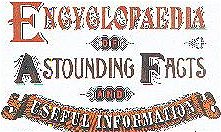
Eclectica Archive |

The Hillmans |

ANNUAL XMAS GREETINGS EDGAR RICE BURROUGHS www.erbzine.com/xmas HILLMAN FAMILY 2012 www.hillmanweb.com/xmas |
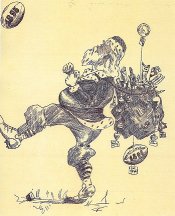
From the ERB Family |
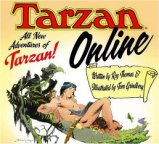 |
An All-New Full-Colour Weekly Tarzan Strip ARTIST Tom Grindberg ~ WRITER Roy Thomas Subscribe Now at the ERB, Inc. Corporate Site Read All About It HERE www.erbzine.com/tarzan |

Play |
California's Jungle Deep is featured on their Website. Listen to the Podcast in MP3 on the Jungle Deep Server and also on our HillmanWeb server: Alternate Podcast Location |

Read |
 |
Still Making Music After All These Years: Bill and Sue-On Hillman "This is a story about a girl who came to a small Manitoba town from China (via Hong Kong) and met a boy with music in his soul. After forty-six years of marriage, Bill and Sue-On Hillman continue to make music – literally and figuratively. . . ." Photo READ THE FULL ARTICLE: HERE |
|
|
Edgar Rice Burroughs
Ref: Cracked.comEdgar Rice Burroughs was an American author who is responsible in many ways for most science fiction related stories since he first began writing in 1912. The novels he wrote are so manly and awesome that they should be taught in schools.
Just The Facts
Edgar Rice Burroughs created characters and worlds like Tarzan of the African Jungle, John Carter of Mars, and David Innes of the inner earth Pellucidar. These characters, in turn, inspired just about everything in science fiction, fantasy, and adventure fiction that was written post-Burroughs. The adventure stories he wrote comprise an encyclopedia of manliness that should be required reading for everyone who ever wants to be a man.Early Life (the Boring Years)
Edgar Rice Burroughs was born in 1875, and didn't really do anything that important for several years. He was unsuccessful at several jobs until he began to work a (still unsuccessful) job as a Pencil Sharpener Salesman. Now two things that are always true about Pencil Sharpener Salesmen are that they have an excess of pencils and an extreme lack of customers. So what do you do when you put the both of those things together? You write like hell, and forever change the face of modern day fiction as we know it.Tarzan
What do you get when a human baby is shipwrecked and raised by gorillas to hunt with his bare hands and eat raw meat while growing up in the deepest, darkest jungle? If you said the superhero origin for an unspeakably manly action hero, you'd be agreeing with almost a hundred years of pop culture. Tarzan's long lasting popularity has led him to be one of the most often portrayed characters in film, and has bridged into just about every imaginable form of media, including movies, TV shows, comics, video games, stage plays, and Broadway musicals. His popularity is so great that numerous unauthorized sequels have cropped up, even some written by the each of the opposing sides of the Israeli and Arab conflict claiming that Tarzan has joined their side.The trademark Tarzan call sound effect is also known the whole world over, and has doubtlessly led to countless imitations in the most appropriate, and inappropriate situations.
While most people think of Tarzan as a barely literate, almost cave man like figure who speaks exclusively in third person; the original character is far more complex. The book itself is a thinking man's commentary on the over simplicity of the pulp stories of the time, presenting a situation where an all powerful hero who lives in a black and white world of absolutes is suddenly thrust into our world of endless complications. He man of the jungle who has knows nothing of man and has thus gained an absolute morality outside of (and above) that of the so-called civilized man's, finds himself suddenly transported to a world of unwritten rules and gray areas. Most complicating of all, he comes to love a woman who loves another man. Even though he is physically, mentally (and later monetarily) superior to this suitor, no feat of strength nor display of prowess can win over his heart's desire from a man she already loves. In reality, there is a Tarzan within all of us, longing for the simplicity of the world of the pulp novel, but forced to exist in our world, where good does not necessarily triumph over evil, and where the hero does not always get the girl. That and he totally fights Nazi's and discovers Atlantis.
John Carter of Mars
If you've ever found yourself in particularly nerdy circles, no doubt you've heard certain people claim that Star Wars is a total rip-off of Dune. This is, of course, complete bunk. Star Wars shamelessly copied several sources, including in several ways John Carter of Mars, and everything it copied from Dune, Dune also had copied from John Carter of Mars.The Martian Tales of Edgar Rice Burroughs tell the ongoing tale of John Carter, an American Civil War veteran (Confederacy; represent!) who suddenly finds himself suddenly on Mars (no seriously, he collapses in a cave, and then suddenly he's there.) No explanation is provided, as no explanation is necessary for a character who proceeds to kick truly ridiculous amount of buttocks. We're talking more than John McClane, The Incredible Hulk, and Alexander the Great combined; in other words, Roosevelt levels of pure butt kicking. He also meets up with the most beautiful Martian princess, who looks like a human only with a reddish skin color, and she's so totally hot that everyone on the planet wants her, thus leading to even more butt kicking.
With one book, A Princess of Mars, the first in a series, Edgar Rice Burroughs would set in motion events that would inspire just about every single science fiction writer to exist within the next several decades. Keep in mind, that this was his second book (sic), the first being Tarzan and we already know how that turned out. Michael Crighton would name an E.R. character after John Carter; Ray Bradbury would admit several times that Burroughs was hugely his inspiration own several counts; and Frank Herbert would pen Dune with the express idea of making a "grown up" version of the Martian Tales (seeing as how replacing butt-kicking with interstellar politics is the golden mean in making "grown up" versions of anything.) When Star Wars came along, it basically took Dune and re-inserted the ungodly amounts of action back into it, and Sci-Fi was made right again. Oh, and did we mention that James Bond and Captain Kirk both share Carter as a part of their inspiration? You may ask which part, and we would respond: only the best part.
The very best part.
That's right, infamous ladies men spanning multiple genres pale in comparison to the amount of alien babes that practically (and sometimes literally) throw themselves at the feet of John Carter. Even beyond this, there still appears to be a consensus agreed upon by multiple writers that the reason H.G. Wells' tripod Martians left Mars in the first place was because they were trying to get away from John Carter. So, yeah, he's pretty much a stone cold badass.Pellucidar
In what is probably the third most popular and famous of Burroughs work was his series about a young man named David Innes who makes his way into the "inner world" of Pellucidar, the world inside the earth's crust that is chock full of dinosaurs, cave men, and psychic pterodactyls. If at this point you would like to point out the copious amounts of reasons as to why the very notion of an inner world is ridiculous, then screw you, you're no fun and we're going home. If you would like to point out that any book about fighting dinosaurs, cave men and psychic pterodactyls is pretty close to the highest level of pure awesome and manliness that human literature has ever achieved, then yes, you would be right.Book Covers
Sure, fine, some of you are not going to be easily swayed by mere literary history and characters who represent the pinnacle of manliness alone. If you need any further proof that Edgar Rice Burroughs is probably the greatest author who ever lived, let me simply show you Exhibit C:A picture's worth a thousand words...

|
|
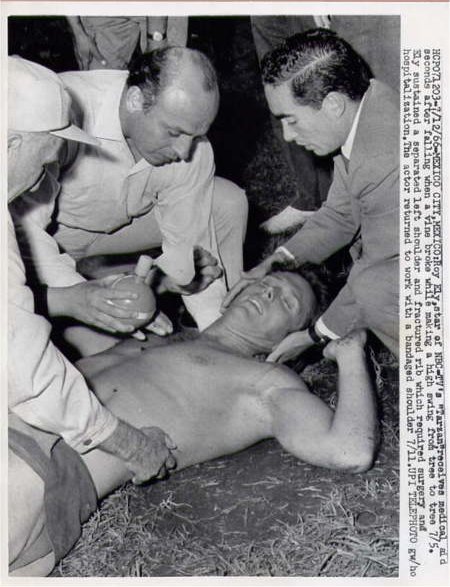
Ron Ely, fallen angel—TV’s Tarzan separated a shoulder and cracked a rib when a vine gave way, but like a trouper, went right back to work. |
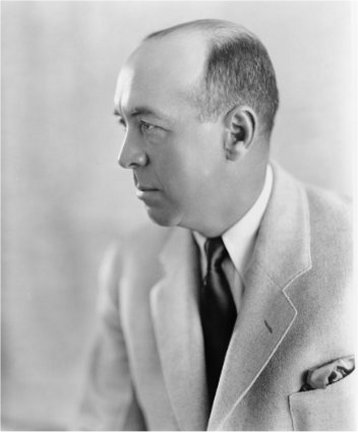
Edgar Rice Burroughs More ERB Portraits have been added to our www.erbzine.com/edgarriceburroughs |

Three Famous Monkeys
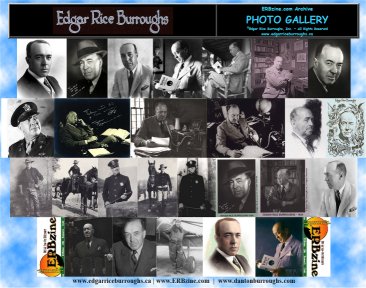
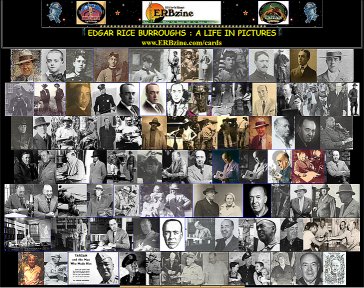


Poster Collages of the
Photos in the ERBzine Archive

Tesla Xmas Tree
|
ERB's Remarkable Summer of '93 Ch. 7: Master Mind of The World of Tomorrow Chicago World's Fair of 1893 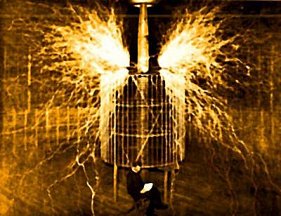
www.erbzine.com/mag12/1281.html |
|
|

Market Watch ~ Dec. 11, 2012 
TARZAN LORD OF THE JUNGLE DOES IT AGAIN
Aristocrat's Tarzan(R) Lord Of The Jungle(TM) Top Jackpot Hits for $334,298.78 at Four Winds Casino Resort
Top Jackpot Has Been Won 19 Times!The Tarzan Lord Of The Jungle top jackpot has been hit 19 times since the game swung onto casino floors last year and has paid out more than $6.4 million in top jackpots. "Operators across North America tell us that their players love to play Tarzan Lord Of The Jungle, and with frequent and large jackpots like these, that's easy to understand!" said Aristocrat VP of Gaming Operations Dallas Orchard.
Beyond operators, players have been saying they love Tarzan Lord Of The Jungle, voting the game Best Video Slot, Best Penny Slot, Luckiest Slot, Best Video Slot Bonus Round, Best Slot Graphics and a top Progressive Slot in the Southern California Gaming Guide "Best Slots 2012 Awards." Plus, readers of Strictly Slots named Tarzan Lord Of The Jungle one of their "Favorite Progressive Slot Machines" in the BEST OF SLOTS 2012.
|
|
Broadway on the Elbe
New York Times ~ December 9, 2012HAMBURG — An eight-hour production of Goethe’s “Faust” may be the highbrow hit of the fall at the grand Thalia state theater here, but it is an altogether different blockbuster — the Disney musical “Tarzan” — that exemplifies why modern Hamburg has become that rare thing in the theater world: a reliable profit center for producers outside of their two biggest markets, New York and London.
“Tarzan” has proved that even out-and-out flops on Broadway can go on to lucrative afterlives in this destination city for Germans, as long as the shows have the spectacle and pageantry that theater producers here say enthrall people across the country. “Tarzan,” composed by Phil Collins, delivers characters swinging on vines over audiences’ heads and generates gasps. While it closed on Broadway in 2007 after 14 months at a loss of roughly $12 million, the show (with some retooling) is in its fifth year here and has become the top-grossing production of this musical in the world, taking in $224 million so far.
“Watching the Tarzan actor and the monkey actors flying above us — it is like nothing I’ve ever seen,” said Katrin Welsch, a recent university graduate who drove here from Saarbrücken, over 300 miles to the south, to take her parents to the show. “It’s like circus but with a love story and music by Phil Collins.”
More than most European cities, Hamburg, known as the Broadway of Europe in some theater circles, has seized on American-style musicals and has turned shows into tourist attractions. For example, most people going to see another Disney musical, “The Lion King,” take a five-minute boat ride across the Elbe River to reach the resplendent tentlike theater, which is visible for miles along the waterfront. And the third big-budget show here, the new musical “Rocky,” puts another famous American movie onstage.
Hamburg’s rise as a hub for musicals — and a more important city to New York producers than capitals like Berlin, Rome, or Paris — has surprisingly little to do with the main costs of doing business, like cast and crew salaries, production expenses and theater rent. (Rents here even account for a slightly higher percentage of a show’s weekly gross than they do on Broadway.) Rather, theater producers and artists here say, it’s all about the enormous audience appetite for musicals — an appetite encouraged by 25 years of producers splashing television ads and billboards across Germany, with its population of 82 million, to market Hamburg as the home of Broadway-style shows. While a few have flourished outside Hamburg — Andrew Lloyd Webber’s critically drubbed roller-skating spectacular “Starlight Express” has been running in the smallish German city of Bochum, near the Dutch border, since 1988 — no other city on the continent is as big a draw for musical-loving tourists.
“Splashy pop-spectacle shows, whether for a date night or part of a hotel’s weekend getaway package, sell far better in Hamburg than almost anywhere else,” said Thomas Schumacher, president of Disney Theatrical Productions, the Broadway-based producing arm that is staging “Tarzan” and “The Lion King” here with its European partner, Stage Entertainment.
“I would never blame my failure with Broadway’s ‘Tarzan’ on audiences,” Mr. Schumacher added. “But the visual language and expressionistic environment and special effects of ‘Tarzan’ have much more appeal in Hamburg.” The Tarzan story, also, has long been well known in Germany.
Yet just as some New York theatergoers denounce the so-called Disneyification of Broadway into a cultural theme park of shiny baubles instead of groundbreaking musicals, the evolution of Hamburg has divided people here on matters of taste as well as commercialism. For more than a century the works of Shakespeare, Schiller, Goethe and Brecht have been the dramatic mainstays, drawing the elite and the bourgeoisie alike to the two major state-supported theaters, the Thalia (founded in 1843) and the Deutsches Schauspielhaus (1901), both near the historic Rathaus, the city hall with its renowned 400-foot tower. The mere mention of the newer musicals, including recent ones like “Dirty Dancing,” “Mamma Mia!” and “Titantic,” draw winces and barnyard epithets from the unruly-haired intellectuals who run the two state theaters, and a somewhat more measured view from officials in charge of cultural affairs here.
“While it’s good to have musicals as a way to get visitors to Hamburg, I worry that these musicals are not producing anything of cultural significance that will last longer beyond the run of the shows themselves,” said Barbara Kisseler, a member of the Hamburg Senate, the city’s main governing body, who oversees the cultural budget. (It provides about $25 million a year each to the Thalia and Schauspielhaus theaters, or most of their budgets. No public money is provided for big commercial musicals.)
“You do not want Germans to give up the classics,” Ms. Kisseler said, “in favor of loud entertainment.”
Hamburg had little experience with musicals until a German entrepreneur, Friedrich Kurz, who had studied theater while living in America, became friendly with Mr. Lloyd Webber in London in the mid-1980s. Mr. Kurz recalled in an interview that he thought a German-language production of Mr. Lloyd Webber’s musical “Cats,” by then a hit in London, New York and Vienna, might be a popular fit at a shabby old music hall in the red-light district of Hamburg, given the show’s high theatricality and themes of memory and faded beauty.
“Cats” began here in 1986, the first big-budget New York-style musical ever to have an open-ended run in Hamburg. It was followed by another Lloyd Webber hit, “The Phantom of the Opera,” and both shows ran for several years. Mr. Kurz and his business partners began making deals with tourism agencies and bus tour operators to promote the musicals — and Hamburg.
“We had signs on the northern German beaches that read, ‘If weather is bad, there’s a show in ‘Hamburg,’ ” Mr. Kurz said. “It didn’t matter whether the shows were good — everyone just wanted to see what people were talking about. So they came to Hamburg.”
As did protesters. University students marched through the city against the arrival of bourgeois musicals and producers like Mr. Kurz and were particularly angry about ticket prices of more than $50 in a city where state-subsidized theaters had long kept prices low. Mr. Kurz recalled gleefully arranging for newspaper photographers to be on hand whenever protesters massed, including on opening night for “Phantom,” in 1990, when Mr. Lloyd Webber insisted on walking the red carpet in his tuxedo in spite of hecklers.
“I never spent much money on marketing because the free publicity was incredible,” said Mr. Kurz, who is now 64, and whose one attempt at producing a spectacle on Broadway — the flop “Carrie,” in 1988 — was a fiasco.
Hamburg’s musical landscape has grown to three theaters, and now the major producer here, Stage Entertainment, is building a fourth, next to the “Lion King” theater on the Elbe. (Most visitors will need to take the boat ride there too.) While Senator Kisseler, for one, is skeptical that “there are enough good musicals for four theaters,” executives at Stage Entertainment see no evidence that ticket buying would slow. They are moving to increase their own product development. While they mostly import shows from Broadway and London and translate them into German, the new $20 million “Rocky” represents their biggest effort so far in developing a musical on their own for Hamburg audiences — and, perhaps, for Broadway audiences.
“As much as we love our musicals from New York like ‘The Lion King’ and ‘Tarzan,’ we also wanted to show that Europe and Hamburg could create a solid musical that New York might want to see,” said Johannes Mock-O’Hara, the managing director of Stage Entertainment for Germany.
Mr. Mock-O’Hara was mum about the inaugural show for Stage’s new fourth theater, which is expected to open in 2014. The lead producers of the Broadway musical “Spider-Man” have talked to him about a possible production in Hamburg someday
“We think our show and its special effects could do very well in Hamburg,” said Michael Cohl, one of the “Spider-Man” producers.
Stage Entertainment will also have to find a show to replace “Tarzan,” which the company plans to close next fall — not because of a sharp drop in ticket sales but to move the production to Stuttgart in hopes of strengthening the company’s business there. While the producers do not expect Stuttgart or any other German city to rival Hamburg, they hope that a high-flying show like “Tarzan” will have wide appeal.
Ms. Welsch, the young university graduate who came to see “Tarzan” in Hamburg recently, had seen the show twice before here. But it was the first musical for her father, Reiner. During an interview at intermission he said he hadn’t made up his mind about the art form. Lingering in the lounge of the Neue Flora theater, decorated with Restoration Hardware-like sofas, he noted he had no points of comparison. Germans did not grow up on this style of musicals, he said, and he had never heard of Stephen Sondheim or even Rodgers and Hammerstein.
“ ‘The Sound of Music’?” he repeated when asked about the famous musical set in Austria just before World War II. “It sounds familiar. I had heard of ‘Tarzan.’ The music is O.K. Do many musicals have flying?”
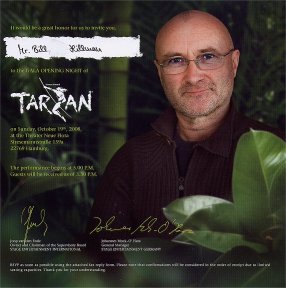
Phil Collins |
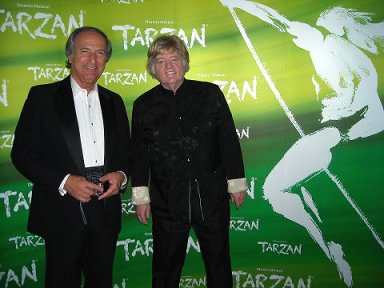
Jim Sullos and Bill Hillman |
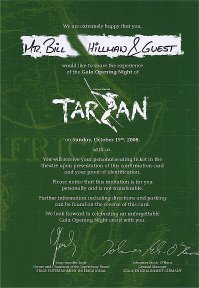
Premiere Invitation |
![]()
Money Pit John Carter Studio executives usually get pegged as the villains when they second-guess a filmmaker's creative vision, but in the case of Walt Disney Pictures' costly sci-fi flop John Carter, a little blowback from studio suits might have been useful.
Wired MagazineThen again, former Disney boss Rich Ross, who left the company a few weeks after John Carter bombed, had reason to remain hands off. John Carter writer-director Andrew Stanton includes Wall*E and Toy Story among his credits. Further box office insurance: the movie was being overseen by Pixar, famous for its freakishly stellar track record since producing Toy Story in 1995.
Who would know better than Stanton / Pixar about what it takes to make a crowd-pleasing smash? But John Carter, shot for a reported $250 million, failed to connect with audiences. Scenarios that probably felt original when Carter creator Edgar Rice Burroughs fantasized about Mars in the 1940's had now been seen hundreds of times on the big screen.
Critics hammered the movie for slow pacing and overly familiar story points despite an army of technically impressive CGI creatures. Fair warning to animation auteurs: live-action's not as easy as it looks. —Hugh Hart
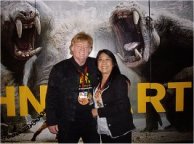
John Carter Art |
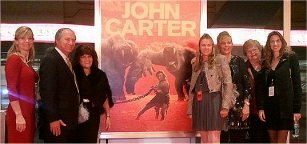
John Carter Photos |

John Carter Posters |
![]()
A
long line of Tarzan and Jane articles and reviews at Robin Maxwell's publisher
site:
www.Tor.com
![]()
Jane: The Woman Who Loved Tarzan by Robin Maxwell Jane: The Woman Who Loved Tarzan by Robin Maxwell is a feminine take on the famous Burroughs novel. This book tells the famous story from the view point of Jane Porter, Tarzan's love interest. It is not a retelling of the origin story of Tarzan, but a reimagining of the mythology originally created by Edgar Rice Burroughs.
BlogCritics.orgJane Porter is the first and only woman at the University of Cambridge to study medicine. She is a fish out of water and already an “old maid” being unmarried in her early twenties. An American explorer named Ral Conrath invites Jane and her father to join his West African expedition they both agree.
However, Ral Conrath has a secret, concerned more with making himself rich with gold, he couldn’t care less about their scientific pursuits. Soon Jane finds herself in danger and discovers that she has a secret admirer, a white man living in the jungle who is thought to be a legend.
I was very excited about this novel, Tarzan has always been a favorite (who can forget those wonderful comics and Johnny Weissmuller films?) and in preparation I read the original Tarzan of the Apes by Edgar Rice Burroughs. To be honest, I was surprised at how much I enjoyed the book again (I read it as a kid), and I can certainly see why it is considered a classic and captures the imagination of the young and young at heart.
Reading the first several pages of Jane, I could tell that Jane would be different. The Jane Porter is this novel is a strong woman, a scientist and trail blazer. Jane tells her story, after a scientific presentation, to author Edgar Rice Burroughs. While this plot device might work, I thought it was a bit awkward especially when Jane, a scholar and an old fashioned woman (in today’s terms) describes intimate details about her relationship. I know very few, if any, women who even today would do so to a complete stranger.
This is by no means a criticism. In Tarzan of the Apes Burroughs skips over the long periods for which it took Tarzan to learn skills. Ms. Maxwell fills in those gaps with slower, more methodical narrative. Being the central character, Jane is certainly interesting throughout, even if a bit vain. I felt Jane’s character grew throughout the novel, from an uptight student to a more animalistic creature less dependent on her protectors (civilized or not) and more willing to take risks in the physical or psychological realms.
Edgar Rice Burroughs, Inc., the company which manages the rights to the author’s work, has approved this novel. According to the author’s note they were actually quite involved in the process. I believe they made the right choice, Ms. Maxwell created Jane as a believable and more grounded character than any man could have (an injured Jane’s concerns performing her bodily functions in front of Tarzan never would have entered my mind).
While the Burroughs books are pure adventure, Jane is more or a romance with adventure sprinkled here and there. I thought the background stories of the characters were interesting but the ending seemed a bit over the top for this novel. Ms. Maxwell set out to write a different Tarzan novel and she succeeded, taking a beloved character and reimagining her completely, but then she went and, in what I could only guess to be an homage to the Burroughs series, created an ending which simply doesn’t match the elegant tale she has weaved.
Despite the ending, I thought Jane was a well-written book about an interesting character who is fun and out of place in her own time. The dialogue was also expressive, compelling, and marked with depth.
A YouTube Video by Jim Sullos Jr. featuring Robin Maxwell at Comic-Con.
http://www.youtube.com/watch?v=0F1i7e9tT9s
Robin Maxwell, Author of Jane: The Woman Who Loved Tarzan
interviewed at San Diego Comic Con 2012
Robin Maxwell’s Jane: The Woman Who Loved Tarzan Best-selling historical-fiction writer Maxwell (To the Tower Born, 2005) is the first woman writer authorized by the Edgar Rice Burroughs estate to create a Tarzan tale, a breakthrough that marks the centenary of Tarzan of the Apes, Burroughs’ first novel featuring the aristocratic ape man and Jane, the intrepid young woman he rescues. Maxwell’s new and improved Jane, a budding scientist undaunted by rampant misogyny, accompanies her professor father to West Africa on a 1905 expedition organized by charming explorer Ral Conrath. But Conrath turns out to be a vicious outlaw, who abandons Jane to die a brutal death. Tarzan, of course, swoops in and rescues her, then, as their unlikely love deepens, she saves him. Maxwell improvises brilliantly on Burroughs’ indelible novel (recently handsomely reissued by the Library of America). In her eventful, keenly imagined, and thrilling tale of African life, colonial crimes, an opulent lost city, and “living missing links” (the primates who raised Tarzan, the orphaned Lord Greystoke), Maxwell also orchestrates glorious sexual awakenings in an Edenic jungle. With riveting action and suspense, earthy humor, a piquant look at the debate over evolution, and the love between heroic, resourceful, and tender Tarzan and smart, strong, and passionate Jane, this is lush and satisfying entertainment.
gets a starred review in Booklist!
“With riveting action and suspense, earthy humor, a piquant look at the debate over evolution, and the love between heroic, resourceful, and tender Tarzan and smart, strong, and passionate Jane, this is lush and satisfying entertainment.”
From Booklist:Cambridge, England, 1905. Jane Porter is hardly a typical woman of her time. The only female student in Cambridge University’s medical program, she is far more comfortable in a lab coat dissecting corpses than she is in a corset and gown sipping afternoon tea. A budding paleoanthropologist, Jane dreams of traveling the globe in search of fossils that will prove the evolutionary theories of her scientific hero, Charles Darwin.
When dashing American explorer Ral Conrath invites Jane and her father to join an expedition deep into West Africa, she can hardly believe her luck. Africa is every bit as exotic and fascinating as she has always imagined, but Jane quickly learns that the lush jungle is full of secrets—and so is Ral Conrath. When danger strikes, Jane finds her hero, the key to humanity’s past, and an all-consuming love in one extraordinary man: Tarzan of the Apes.
Jane is the first version of the Tarzan story written by a woman and authorized by the Edgar Rice Burroughs estate. Its publication marks the centennial of the original Tarzan of the Apes.
John Carter' (Andrew Stanton)
Moviefone.comIt's weird to think of a $200 million Disney event movie directed by the filmmaker behind "Finding Nemo" as a "lost" film, but that's exactly what "John Carter" was. Based on a series of hugely influential, hundred-year-old pulp novels by Edgar Rice Burroughs, and flattened by the one-two punch of bad press and pour marketing, "John Carter" died a dog's death at the box office this spring, despite being a deeply strange, wildly imaginative and hugely personal blockbuster.
True, "John Carter" is a discombobulated mess, often times getting lost in a tangle of subplots and arcane terminology, but it works more often than it should, and has an easygoing, overtly earnest charm that's hard to shrug off. Taylor Kitsch, from "Friday Night Lights," plays the title role, a grumpy Confederate soldier zapped to Mars (that tired old story).
Andrew Stanton, a Pixar veteran, made his live action debut with "John Carter," and the action sequences have a zippy inventiveness befitting someone with an animation background (the script was co-written by Pulitzer Prize-winning novelist Michael Chabon), often resulting in bold, sometimes deeply unsettling decisions.
Known primarily as an astronomical financial dud, "John Carter" will one day rightfully be recognized for what it truly is -- an utterly winning cult classic.
ERBzine's John Carter Film Site:
www.cartermovie.com
|
|
|
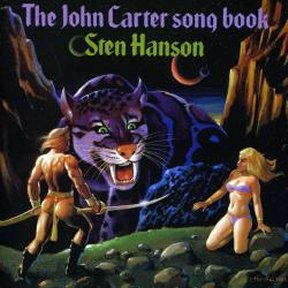 |
(Phono Suecia/1988) Battlesong Of Tars Tarkas And The Green Warriors (6:25) Bestiary (2:06) The Chessmen Of Mars (3:44) Song Of The Holy Terns (2:28) The Love Song Of The Red Princess (10:00) The Birthplace Of Matter (10:29) Fylkingen studios, Institute of Electro-Acoustic music, Radiohuset, Stokholm and at the studio of Brooklyn College, New York. Sten Hanson (b. 19136) plays vibraphone and Buchla synthesizer. |
|
|
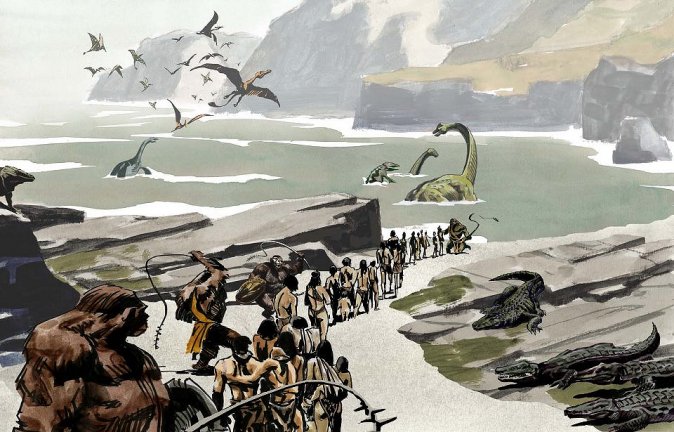
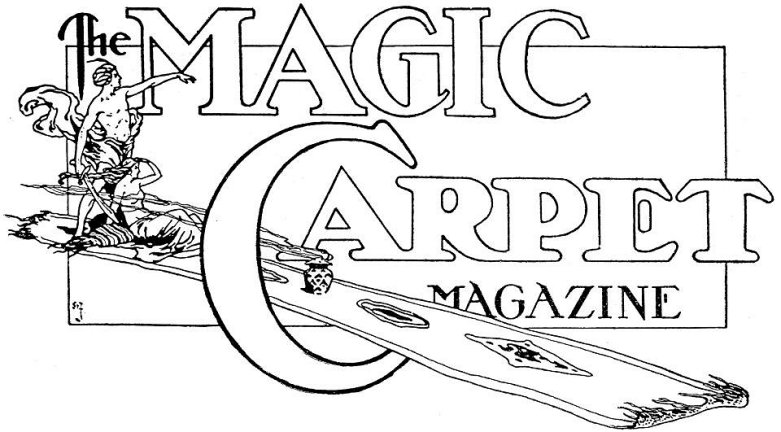

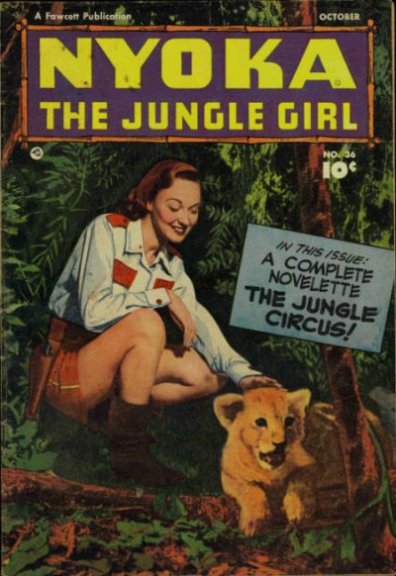
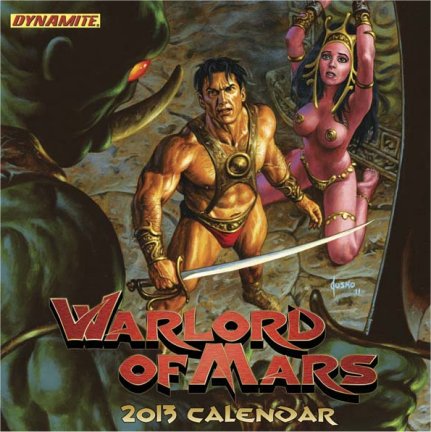
|
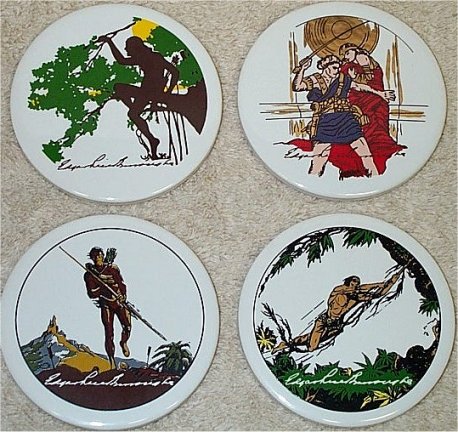
Tarzan and John Carter coasters from the '70s: * Fred Arting from Tarzan of the Apes * Recreation of Frank Schoonover’s A Princess of Mars * John Coleman Burroughs from Tarzan and “The Foreign Legion” *Burne Hogarth’s Tarzan |
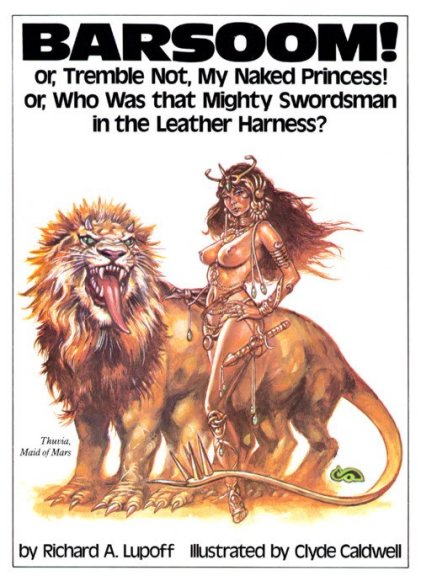
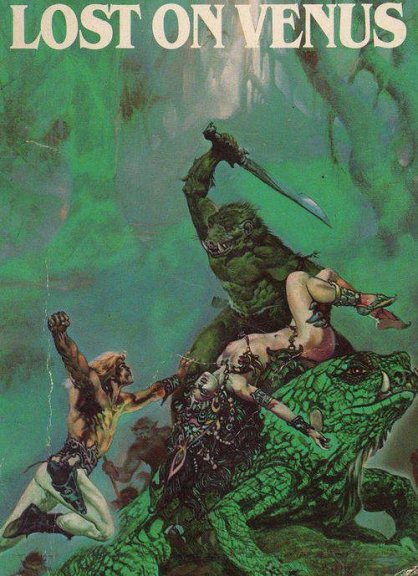

Tarzan: The Light of Knowledge
Cynthia
Sheppard Illustrations
|
|
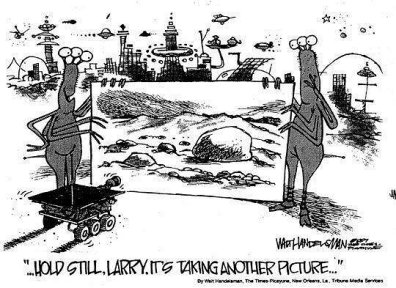
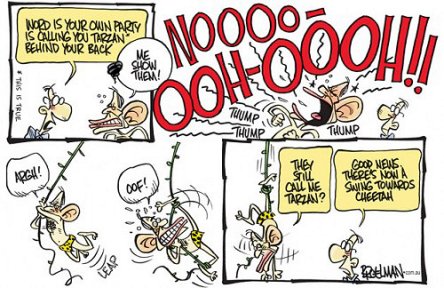



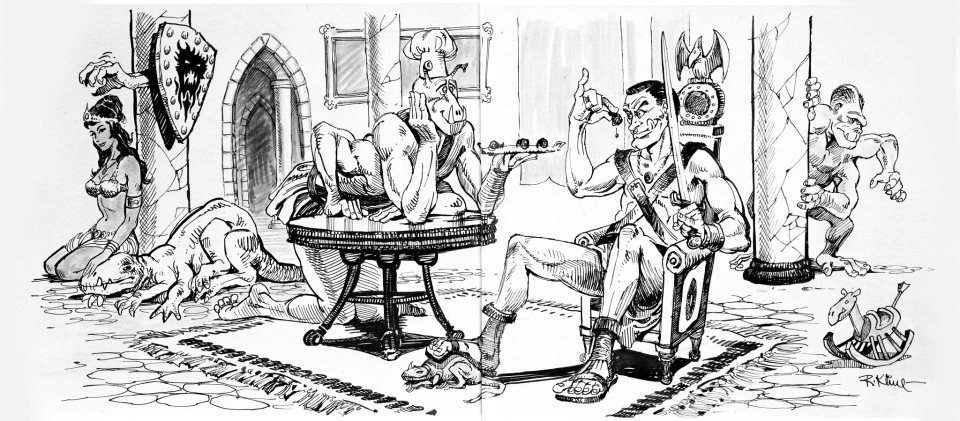
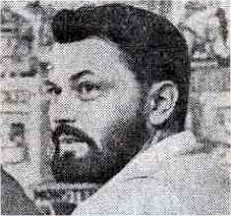
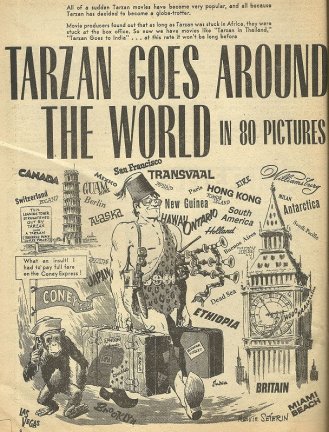
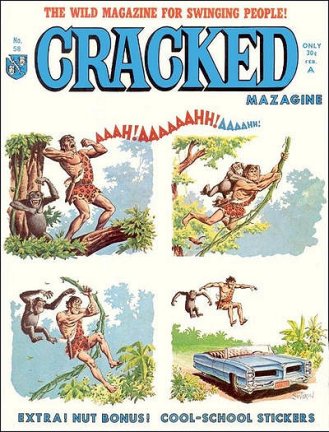
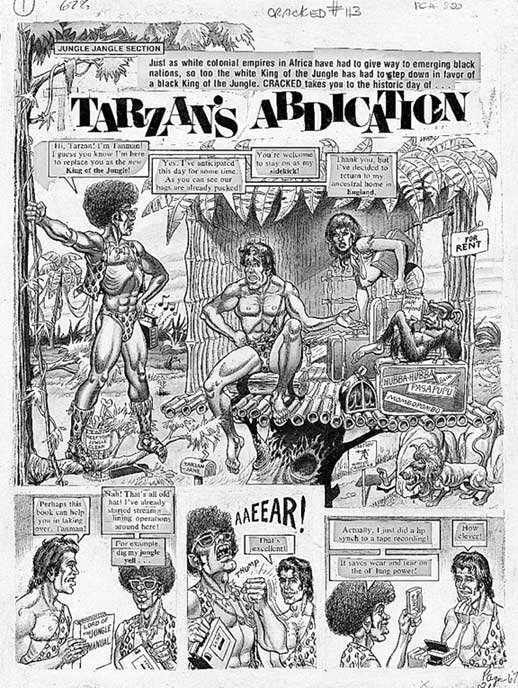
Bill Ward Tarzan Parody - Cracked 113
![]()

![]()
![]()
BILL
HILLMAN: Editor and Webmaster
BILL
AND SUE-ON HILLMAN ECLECTIC STUDIO
ERB
Text, ERB Images and Tarzan® are ©Edgar Rice Burroughs, Inc.-
All Rights Reserved.
All
Original Work ©1996-2012 by Bill Hillman and/or Contributing Authors/Owners
No
part of this web site may be reproduced without permission from the respective
owners.